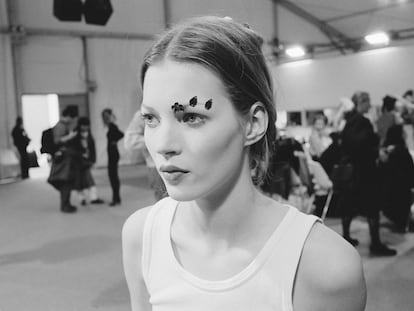The Mary-Kate and Ashley paradigm: why are the Olsen twins still so fascinating?
Millennial women are still obsessed with the celebrity sisters who became famous as little girls. A documentary directed by a fan explores their cultural legacy
“Was it Full House?” asks a female voiceover at the beginning of the documentary The Twins. “Was it fame? Was it fashion? Was it coffee cups, cigarettes and sunglasses? Or is it nostalgia? What is it about twins that makes them so mysterious? What is it that draws us in? What is it about them? Are you a Mary-Kate, or are you an Ashley?” A series of images of Mary-Kate and Ashley Olsen flash across the screen. The voice belongs to the Indian-British documentarian Zara Meerza, who, through the film, tries to understand and explain millennial women’s collective obsession with the Olsen twins, along with the celebrities’ cultural impact and legacy.
Everyone knows the Olsens: child stars since nine months old, thanks to the success of the TV sitcom Full House and later the movie It Takes Two. As they got older, they grew up along with their audience. They starred in teen films about entanglements and chaste crushes, in which the sisters already showed off their two distinct and marked personalities: Ashley was the good girl, Mary-Kate was the bad girl. In 2004, when they starred in the comedy New York Minute, they were 18 years old and had an estimated fortune of $137 millions. With their coming of age, they became fashion icons, carrying the flag of boho-chic style. The world was watching them. The paparazzi and the press harassed them. The public sexualized them: there was an online countdown to determine when it would be legal to sleep with them. In 2010, in one of the few interviews they gave, Mary-Kate told Marie Claire magazine that she did not wish “anyone” the childhood she had lived: “We were like little monkey performers.” Today, the women have chosen to avoid the spotlight. They became fashion entrepreneurs with their brand The Row, which won them the 2012 CFDA award for Womenswear Designer of the Year. Currently, their fortune is estimated at $500 million.
The Olsen twins reached a kind of fame unlike anything that stars today experience. In an interview with the WePresent content platform, where the documentary is available to stream, Meerza said, “Because of social media, there’s just no mystique about anyone anymore. [Our relationship with the Olsen twins] is an old-school form of fandom that doesn’t really exist anymore.”
Meerza was a fan of the sisters. Born and raised in London, she recounts how her father and her relatives would bring her collectible Mary-Kate and Ashley items only sold in the United States. Meerza, like many of her friends and peers, was fascinated by them. In the documentary she talks about how much she admired their indestructible bond, their sisterhood, their guts, their winning way of overcoming problems and also their style. But, above all, she admired that they represented a world in which any girl could be whoever she wanted: “There’s something really powerful about them being pure individuals, but still so united.” Perhaps the key to everything lies in the last question at the beginning of the documentary: “Are you a Mary-Kate, or are you an Ashley?”
In an episode of the animated series Bojack Horseman —a fine-tuned satire of the Hollywood industry, whose protagonist is an aging former sitcom star— various actors, writers and journalists analyze two characters from a TV show. The characters, Zöe and Zelda, are a reflection of the Olsens. Zöe, as Mary-Kate, always played the rebellious character, the masculine girl who loved sports, introverted, ironic and sarcastic. Zelda, like Ashley, played the good girl with good grades, sweet, outgoing and optimistic. As the Bojack characters observe, the Zoë/Zelda paradigm can define everyone in the world, from Barack Obama to Donald Trump, from Britney Spears to Christina Aguilera. And it resonated with those teenagers, now millennial women, who discovered their identity through the Olsens’ films, replete with stereotypes but also with possibilities.
The fascination with the Olsen twins goes beyond Full House, fame, fashion or the images of them smoking on the streets of New York. It is about identity and transformation. Growing up, Meerza bought the magazines that featured them. Now, she aspires to be able to buy an outfit from The Row. Women saw themselves reflected in the paradigm of Mary-Kate and Ashley, so similar and still so different. And they learned that, in an ideal sisterhood, a Mary-Kate would always have an Ashley by her side.
Tu suscripción se está usando en otro dispositivo
¿Quieres añadir otro usuario a tu suscripción?
Si continúas leyendo en este dispositivo, no se podrá leer en el otro.
FlechaTu suscripción se está usando en otro dispositivo y solo puedes acceder a EL PAÍS desde un dispositivo a la vez.
Si quieres compartir tu cuenta, cambia tu suscripción a la modalidad Premium, así podrás añadir otro usuario. Cada uno accederá con su propia cuenta de email, lo que os permitirá personalizar vuestra experiencia en EL PAÍS.
¿Tienes una suscripción de empresa? Accede aquí para contratar más cuentas.
En el caso de no saber quién está usando tu cuenta, te recomendamos cambiar tu contraseña aquí.
Si decides continuar compartiendo tu cuenta, este mensaje se mostrará en tu dispositivo y en el de la otra persona que está usando tu cuenta de forma indefinida, afectando a tu experiencia de lectura. Puedes consultar aquí los términos y condiciones de la suscripción digital.
More information
Últimas noticias
Trump claims peace in Ukraine is near, but Moscow suggests otherwise
A survivor’s account of the Interoceanic Train accident: ‘We were scared because of the speed on the curve’
The Interoceanic Train, the Mexican alternative to the Panama Canal
What is known about the Interoceanic Train derailment in Oaxaca
Most viewed
- Oona Chaplin: ‘I told James Cameron that I was living in a treehouse and starting a permaculture project with a friend’
- Reinhard Genzel, Nobel laureate in physics: ‘One-minute videos will never give you the truth’
- Why the price of coffee has skyrocketed: from Brazilian plantations to specialty coffee houses
- Pablo Escobar’s hippos: A serious environmental problem, 40 years on
- Chevy Chase, the beloved comedian who was a monster off camera: ‘Not everyone hated him, just the people who’ve worked with him’












































